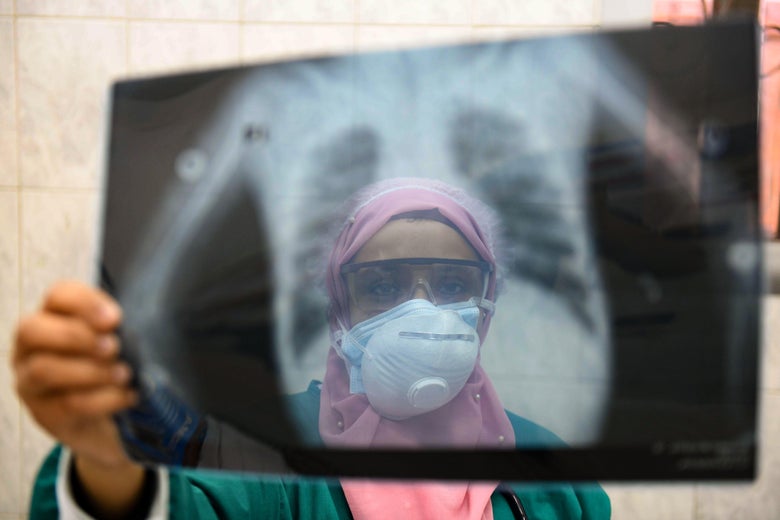
In March of 1905, doctors at a hospital in Philadelphia tried something unconventional to treat a man with a bad case of pneumonia: they blasted his right lung, where the infection was concentrated, with x-rays. This radiation treatment took five minutes a day, for four days, as a paper published that year describes. By the end of the week, the pneumonia had cleared. "One case proves nothing," the authors caution, "but this result is sufficiently suggestive to encourage further trial in other cases of unresolved pneumonia."
Further trials, in hundreds of patients, showed excellent results. But interest in radiation to treat infections languished after the introduction of antibiotics in 1939. The most recent human study of radiation for pneumonia was from 1943-nearly 80 years ago. But now, with no antibiotics available to treat COVID-19 pneumonia, researchers are once again doing trials to treat lung infections with radiation. There are currently trials underway at Emory University, Ohio State University, Brigham and Women's Hospital in Boston, and in Italy, Spain, India and Iran.
Though it's sometimes used to sterilize viruses on hospital equipment, radiation doesn't target the virus outright in these trials. It would be too much for the body to handle. Viruses are much smaller than the DNA in cancer cells, and require a much higher dose of radiation to kill. Instead, radiation treatment for pneumonia targets the body's immune system. The most common cause of respiratory distress in coronavirus patients is an overwhelming immune response. In attempt to combat the coronavirus, immune cells called lymphocytes create cytokines-a class of cell-signaling molecule-which result in too much fluid in the lungs, preventing breathing. Some trials for COVID-19 patients look at drugs that block cytokines. Radiation, instead, attempts to prevent cytokines from being overproduced in the first place, by targeting lymphocytes. Lymphocytes are exquisitely sensitive to radiation, going through apoptosis-programmed cell death-when they detect even a little damage to their DNA. The radiation dose used in the Emory trial, 1.5 Gray, is high enough to inactivate lymphocytes, but much lower that typical doses used to treat cancer, which is often around 60 Gray.
Very early results from the Emory trial are promising, according to a report that has not yet gone through peer review. Doctors treated five patients with coronavirus in the trial. With a median age of 90, the patients were in a high-risk group for the disease. All were receiving supplemental oxygen. Four of these patients recovered to the point where doctors could wean them off oxygen within a matter of days. The fifth patient was still alive at the time the paper was uploaded, but was still on oxygen 14 days after radiation. There were no acute side effects. We'll need data from more patients to know if these results are typical. The Ohio State study aims to enroll 24 patients, and the Brigham and Women's Hospital study 48, but neither has completed enrollment yet. Once the results of additional trials are out, doctors will have a better grasp on how well radiation works for COVID-19 pneumonia, and which patients could benefit most from this treatment.
If it works, there would be a few large upsides to using radiation to treat coronavirus versus other options. Insurance reimbursement rates for radiation planning and treatment are fixed, as opposed to drug prices which may fluctuate depending on demand. Unlike some anti-inflammatory drugs, radiation wouldn't interact with other medications patients might be taking. Any treatment that keeps patients off ventilators, or shortens their time on a ventilator, will help not only that patient but also ease the strain on our nation's limited intensive care resources. Though it would take time to come up with treatment protocols specific to COVID-19 patients, there is significant capacity in radiation oncology clinics throughout the country to handle extra treatments.
And if radiation works for COVID-19, it may spur research into how it could be used for other viral pneumonias. The Centers for Disease Control estimates that approximately 40,000 Americans die each year from influenza, in a manner similar to COVID-19 patients. Yes, whether radiation will work reliably to treat lung infections is still something of an open question. But it's possible that we'll end up with a life-saving medical advancement that is useful well beyond coronavirus, and which never would have been resurfaced without the pandemic.